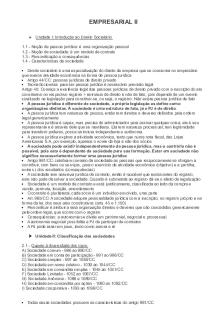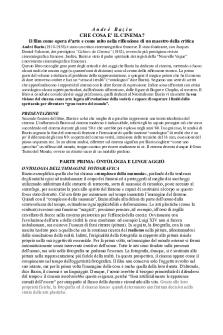Andre Bazin 1.30 PDF

| Title | Andre Bazin 1.30 |
|---|---|
| Course | Film and Media Theory |
| Institution | Vanderbilt University |
| Pages | 2 |
| File Size | 40.5 KB |
| File Type | |
| Total Downloads | 68 |
| Total Views | 163 |
Summary
Lecture notes on bazin
prof Jen Fay...
Description
The myth of Total Cinema Keep in mind filmmaker model is very different from the director role Cinema was before its time but also seems delayed in its development Total cinema: cannot be reached, will never be reality because the development of cinema is constantly evolving Integral realism Myth of total cinema: the route toward total cinema will never end, o move towards objectivity o "in their imaginations, they saw cinema as a total and complete representation of reality, the reconstruction of a perfect illusion of the outside world in sound, color, and relief" (20) o Utopian hope that maybe one could record a world objectivity, not with the hand of creativity o Finding tech. that enables us to record the world again as a singularity in as complete a record as possible Cinema is not arresting movement, it is reproducing it The engineers had the technology suitable for film, but they were not thinking about cinema o It took that vision or desire to realize what could be possible For Arnheim, recreating reality in cinema is recreating Inattentive movement that we have in the world Evolution of the Language of Cinema Bazin: Two trends in silent Cinema o Image trend Plastics (German expressionism) Strives after moving painting, but not reality (Cabinet of Dr. Caligari) Montage (Soviet Montage) as a manipulation of reality Doing violence to reality, ruling out ambiguity by Being given and told a certain feeling No image by itself has a meaning Sometimes objects are never seen in the same frame Meaning owes everything to montage, and nothing to reality o Reality trend Weaker than image trend Where the dialectics come into play, documentary realism o Two opposing terms come together to form a new term, continuity editing seems to be a compromise After coming of sound: radical expressionism and Soviet montage fall away. Continuity editing becomes a norm A movement toward long takes, deep space, deep focus, but through the lessons of continuity editing o With continuity editing, you can move people around and light each shot differently and put it together as the same moment o Doesn't owe its entire meaning to montage o Using resources of staging, depth of field, and long take to keep all the action together and realistic o Active spectator Cutoff line is not movement from silent to sound...
Similar Free PDFs

orson welles andre bazin
- 5 Pages

Andre Bazin 1.30
- 2 Pages

BIO 130
- 9 Pages

Sonnet 130
- 7 Pages

Andre and Velasquez 1992
- 3 Pages

Empresa II - Professor Andre Saad
- 19 Pages

Processo civil - Prof Andre
- 2 Pages

ECON 130 Roberts Michael
- 5 Pages

André Bazin, Che cosa è il cinema
- 26 Pages

Chem 130 Syllabus F17
- 9 Pages

Benedict pg. 124-130
- 2 Pages

I-130 - nursing work
- 12 Pages

PTA 130 - Tilt Table
- 3 Pages

FInals- CHEM 130 summary
- 40 Pages
Popular Institutions
- Tinajero National High School - Annex
- Politeknik Caltex Riau
- Yokohama City University
- SGT University
- University of Al-Qadisiyah
- Divine Word College of Vigan
- Techniek College Rotterdam
- Universidade de Santiago
- Universiti Teknologi MARA Cawangan Johor Kampus Pasir Gudang
- Poltekkes Kemenkes Yogyakarta
- Baguio City National High School
- Colegio san marcos
- preparatoria uno
- Centro de Bachillerato Tecnológico Industrial y de Servicios No. 107
- Dalian Maritime University
- Quang Trung Secondary School
- Colegio Tecnológico en Informática
- Corporación Regional de Educación Superior
- Grupo CEDVA
- Dar Al Uloom University
- Centro de Estudios Preuniversitarios de la Universidad Nacional de Ingeniería
- 上智大学
- Aakash International School, Nuna Majara
- San Felipe Neri Catholic School
- Kang Chiao International School - New Taipei City
- Misamis Occidental National High School
- Institución Educativa Escuela Normal Juan Ladrilleros
- Kolehiyo ng Pantukan
- Batanes State College
- Instituto Continental
- Sekolah Menengah Kejuruan Kesehatan Kaltara (Tarakan)
- Colegio de La Inmaculada Concepcion - Cebu

